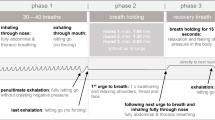Abstract
A novel principle of short-term periodic adaptive training by varying the oxygen level from hypo- to hyperoxia is substantiated both theoretically and experimentally. Short-term adaptation to hypoxia-normoxia produced a membrane-protective effect in the heart and cerebral cortex, but increased the sensitivity to free radical oxidation and decreased the level of components of the antioxidant defense system in the liver. Hypo-hyperoxia adaptation produced a membrane-stabilizing effect in the heart, brain, and liver, which was more pronounced compared to the effect of hypoxia-normoxia training. In contrast to hypoxia-normoxia adaptation, in case of hypo-hyperoxia training the adaptive defense developed as early as 15 days after the start of training.
Similar content being viewed by others
REFERENCES
E. Z. Maev, P. V. Kozyrev, N. V. Vinogradov, et al., in: Problems of Hypoxia: Molecular, Physiological, and Medical Aspects [in Russian], Eds. L. D. Luk'yanova and I. B. Ushakov, Moscow (2004), pp. 569–579.
A. E. Platonov, Statistical Analysis in Medicine and Biology: Problems, Terminology, Logics, and Computer Methods [in Russian], Moscow (2000).
T. G. Sazontova and Yu. V. Arkhipenko, in: Problems of Hypoxia: Molecular, Physiological, and Medical Aspects [in Russian], Eds. L. D. Luk'yanova and I. B. Ushakov, Moscow (2004), pp. 112–138.
T. G. Sazontova, Yu. V. Arkhipenko, and F. Z. Meerson, Byull. Eksp. Biol. Med., 103, No.10, 411–413 (1987).
T. G. Sazontova, Yu. V. Arkhipenko, and F. Z. Meerson, Ibid., 120, No.7, 42–45 (1995).
T. G. Sazontova, N. E. Golantsova, F. Z. Meerson, and Yu. V. Arkhipenko, Ibid., 122, No.6, 623–627 (1996).
Yu. V. Arkhipenko and T. G. Sazontova, Pathophysiology, No. 2, 131–140 (1995).
Yu. V. Arkhipenko, T. G. Sazontova, E. N. Tkatchouk, and F. Z. Meerson, in: Adaptation Biology and Medicine, Eds. B. K. Sharma et al., Vol. 1, Subcellular Basis, New Delhi (1997), pp. 251–259.
M. L. Hu, E. N. Frankel, B. E. Leibowitz, and A. L. Tappel, J. Nutr., 119, 1574–1582 (1989).
K. Kikugawa, T. Kojima, S. Yamaki, and H. Kosugi, Analyt. Biochem., 202, 249–255 (1992).
H. Ohkawa, N. Ohishi, and K. Yagi, Ibid., 95, 351–358 (1979).
S. K. Powers, D. Criswell, J. Lawler, et al., Am. J. Physiol., 266, No.2, Pt. 2, R375–R380 (1994).
T. G. Sazontova, E. N. Tkatchouk, S. N. Kolmykova, et al., Hypox. Med. J., 2, No.4, 4–7 (1994).
Author information
Authors and Affiliations
Corresponding author
Additional information
__________
Translated from Byulleten' Eksperimental'noi Biologii i Meditsiny, Vol. 140, No. 9, pp. 257–260, September, 2005
Rights and permissions
About this article
Cite this article
Arkhipenko, Y.V., Sazontova, T.G. & Zhukova, A.G. Adaptation to Periodic Hypoxia and Hyperoxia Improves Resistance of Membrane Structures in Heart, Liver, and Brain. Bull Exp Biol Med 140, 278–281 (2005). https://doi.org/10.1007/s10517-005-0466-0
Received:
Issue Date:
DOI: https://doi.org/10.1007/s10517-005-0466-0




